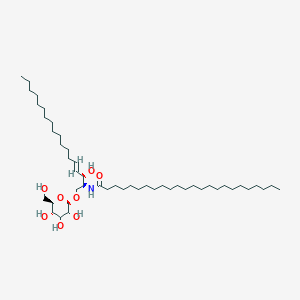| MeSH term | MeSH ID | Detail |
|---|---|---|
| Leukodystrophy, Metachromatic | D007966 | 4 associated lipids |
| Niemann-Pick Diseases | D009542 | 25 associated lipids |
| Gaucher Disease | D005776 | 13 associated lipids |
| Abetalipoproteinemia | D000012 | 7 associated lipids |
| Lipidoses | D008064 | 7 associated lipids |
| Fatigue | D005221 | 10 associated lipids |
| Infarction | D007238 | 3 associated lipids |
| Epilepsies, Myoclonic | D004831 | 2 associated lipids |
| Venous Thrombosis | D020246 | 11 associated lipids |
| Uveitis, Intermediate | D015867 | 3 associated lipids |
C24 GlcCer
C24 GlcCer is a lipid of Sphingolipids (SP) class. The related experimental models are Knock-out.
Cross Reference
Introduction
To understand associated biological information of C24 GlcCer, we collected biological information of abnormalities, associated pathways, cellular/molecular locations, biological functions, related genes/proteins, lipids and common seen animal/experimental models with organized paragraphs from literatures.
What diseases are associated with C24 GlcCer?
There are no associated biomedical information in the current reference collection.
Possible diseases from mapped MeSH terms on references
We collected disease MeSH terms mapped to the references associated with C24 GlcCer
PubChem Associated disorders and diseases
What pathways are associated with C24 GlcCer
There are no associated biomedical information in the current reference collection.
PubChem Biomolecular Interactions and Pathways
Link to PubChem Biomolecular Interactions and PathwaysWhat cellular locations are associated with C24 GlcCer?
There are no associated biomedical information in the current reference collection.
What functions are associated with C24 GlcCer?
There are no associated biomedical information in the current reference collection.
What lipids are associated with C24 GlcCer?
There are no associated biomedical information in the current reference collection.
What genes are associated with C24 GlcCer?
There are no associated biomedical information in the current reference collection.
What common seen animal models are associated with C24 GlcCer?
Knock-out
Knock-out are used in the study 'Rho/ROCK pathway is essential to the expansion, differentiation, and morphological rearrangements of human neural stem/progenitor cells induced by lysophosphatidic acid.' (Frisca F et al., 2013).
Related references are published most in these journals:
| Model | Cross reference | Weighted score | Related literatures |
|---|
NCBI Entrez Crosslinks
All references with C24 GlcCer
Download all related citations| Authors | Title | Published | Journal | PubMed Link |
|---|---|---|---|---|
| Adar T et al. | Aggregation of red blood cells in patients with Gaucher disease. | 2006 | Br. J. Haematol. | pmid:16827817 |
| Hollak CE et al. | [From gene to disease; Gaucher disease]. | 2005 | Ned Tijdschr Geneeskd | pmid:16223076 |
| Deguchi H et al. | Decreased plasma sensitivity to activated protein C by oral contraceptives is associated with decreases in plasma glucosylceramide. | 2005 | J. Thromb. Haemost. | pmid:15869587 |
| Harzer K et al. | Concurrent increase of cholesterol, sphingomyelin and glucosylceramide in the spleen from non-neurologic Niemann-Pick type C patients but also patients possibly affected with other lipid trafficking disorders. | 2003 | FEBS Lett. | pmid:12606053 |
| Mariani G et al. | Severity of bone marrow involvement in patients with Gaucher's disease evaluated by scintigraphy with 99mTc-sestamibi. | 2003 | J. Nucl. Med. | pmid:12902415 |
| Campbell PE et al. | A model of neuronopathic Gaucher disease. | 2003 | J. Inherit. Metab. Dis. | pmid:14707511 |
| Poll LW et al. | Response of Gaucher bone disease to enzyme replacement therapy. | 2002 | Br J Radiol | pmid:12036830 |
| Schaison G et al. | [French results of enzyme replacement therapy in Gaucher's disease]. | 2002 | Bull. Acad. Natl. Med. | pmid:12412377 |
| Stirnemann J and Belmatoug N | [Adult Gaucher disease]. | 2001 | Rev Med Interne | pmid:11794882 |
| Liu Y et al. | Mice with type 2 and 3 Gaucher disease point mutations generated by a single insertion mutagenesis procedure. | 1998 | Proc. Natl. Acad. Sci. U.S.A. | pmid:9482915 |
